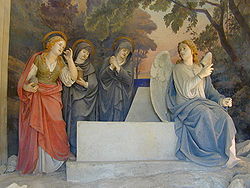- Matthew 28:5–6
-
Matthew 28:5-6 are the fifth and sixth verses of the twenty-eighth chapter of the Gospel of Matthew in the New Testament. This verse is part of the resurrection narrative. An angel has appeared at the empty tomb and in this verse he gives instructions to Mary Magdalene and "the other Mary".
The original Koine Greek, according to Westcott and Hort, reads:
- 5: αποκριθεις δε ο αγγελος ειπεν ταις γυναιξιν μη φοβεισθε
- υμεις οιδα γαρ οτι ιησουν τον εσταυρωμενον ζητειτε
- 6: ουκ εστιν ωδε ηγερθη γαρ καθως ειπεν
- δευτε ιδετε τον τοπον οπου εκειτο
In the King James Version of the Bible it is translated as:
- 5: And the angel answered and said unto the women, Fear not
- ye: for I know that ye seek Jesus, which was crucified.
- 6: He is not here: for he is risen, as he said.
- Come, see the place where the Lord lay.
The modern World English Bible translates the passage as:
- 5: The angel answered the women, “Don’t be afraid, for I
- know that you seek Jesus, who has been crucified.
- 6: He is not here, for he has risen, just like he said.
- Come, see the place where the Lord was lying.
For a collection of other versions see BibRef Matthew 28:5
After a short diversion found only in Matthew, 28:5 has Matthew rejoining Mark, with these verses parallelling Mark 16:7. In Mark the women had felt fear at the presence of the angel, but in Matthew only the guards are mentioned as being afraid so the connection is less direct in this gospel.[1] In the previous verse the guards were so struck by fear that they collapsed. Keener notes that the angel had no interest in assuaging the fear of the guards, making it clear that the message of the angel is intended for only the women.[2] An angel issues the same "do not to be afraid" at Matthew 1:20, implying that this is perhaps the same angel as the in the infancy narrative.[3]
The words of the angel are almost identical to the ones spoken by it in Mark. One change is that in Mark the Jesus is called "the Nazarean." Unlike Mark, Matthew does not generally use that title, and it's dropped several times in his gospel.[4] The tense of the word translated as crucified specifically denotes a complete act with continuing consequences, emphasizing the importance of the event.[5] Since Matthew has the women still outside of the tomb, this verse also deviates from Mark by having the angel request that the women enter the tomb.[6] In Mark the angel invites the women to see where "they put him," but Matthew had Joseph of Arimathea acting alone, so he drops the they and reorders that part of the sentence.[7]
These verses are part of a series of pieces of evidence Matthew presents to prove the truth of the resurrection story and refute the stolen body hypothesis, which at this time was being advanced by non-Christians. Having the women enter the tomb confirms that it was empty just after the stone was removed.[8] These are also the same women that had earlier witnesses Jesus' interment at Matthew 27:60-61, so there is no doubt of a mistake.[9] The angel also references back to Jesus' prophesies of his own resurrection, thus helping confirm that Jesus was a true prophet.[10]
References
- ^ Nolland, John. The Gospel of Matthew: a commentary on the Greek text. Wm. B. Eerdmans Publishing, 2005 pg. 1248
- ^ Keener, Craig S. The Gospel of Matthew: A Socio-Rhetorical Commentary. Wm. B. Eerdmans Publishing, 2009. pg. 701
- ^ Davies, W.D. and Dale C. Allison, Jr. A Critical and Exegetical Commentary on the Gospel According to Saint Matthew. Edinburgh : T. & T. Clark, 1988-1997. pg. 542
- ^ Nolland, John. The Gospel of Matthew: a commentary on the Greek text. Wm. B. Eerdmans Publishing, 2005 pg. 1248
- ^ Boring, Eugene "Gospel of Matthew." The New Interpreter's Bible, volume 8 Abingdon, 1995 pg. 499
- ^ Nolland, John. The Gospel of Matthew: a commentary on the Greek text. Wm. B. Eerdmans Publishing, 2005 pg. 1249
- ^ Gundry, Robert H. Matthew a Commentary on his Literary and Theological Art. Grand Rapids: William B. Eerdmans Publishing Company, 1982. pg. 589
- ^ Nolland, John. The Gospel of Matthew: a commentary on the Greek text. Wm. B. Eerdmans Publishing, 2005 pg. 1244
- ^ France, R.T. The Gospel According to Matthew: an Introduction and Commentary. Leicester: Inter-Varsity, 1985.
- ^ Davies, W.D. and Dale C. Allison, Jr. A Critical and Exegetical Commentary on the Gospel According to Saint Matthew. Edinburgh : T. & T. Clark, 1988-1997. pg. 543
Gospel of Matthew Preceded by:
Matthew 28:4Chapter 28 Followed by:
Matthew 28:7Categories:- Gospel of Matthew verses
- Angels in Christianity
- Resurrection of Jesus
Wikimedia Foundation. 2010.

